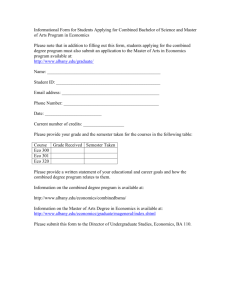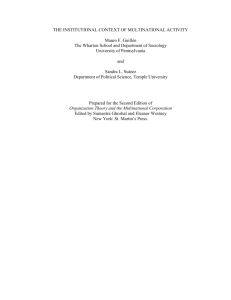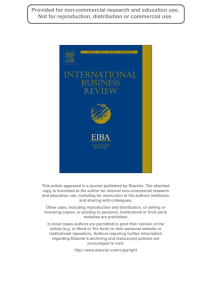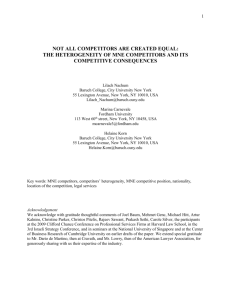APPLIED ECONOMICS IN INTERNATIONAL BUSINESS 2014 V1
advertisement
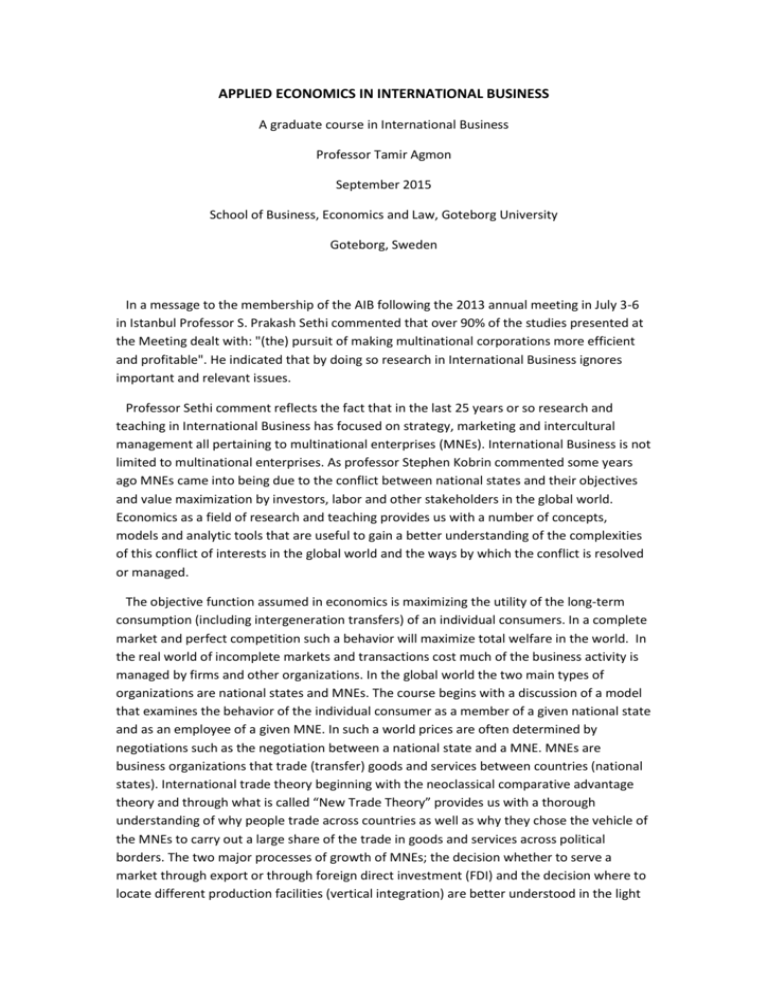
APPLIED ECONOMICS IN INTERNATIONAL BUSINESS A graduate course in International Business Professor Tamir Agmon September 2015 School of Business, Economics and Law, Goteborg University Goteborg, Sweden In a message to the membership of the AIB following the 2013 annual meeting in July 3-6 in Istanbul Professor S. Prakash Sethi commented that over 90% of the studies presented at the Meeting dealt with: "(the) pursuit of making multinational corporations more efficient and profitable". He indicated that by doing so research in International Business ignores important and relevant issues. Professor Sethi comment reflects the fact that in the last 25 years or so research and teaching in International Business has focused on strategy, marketing and intercultural management all pertaining to multinational enterprises (MNEs). International Business is not limited to multinational enterprises. As professor Stephen Kobrin commented some years ago MNEs came into being due to the conflict between national states and their objectives and value maximization by investors, labor and other stakeholders in the global world. Economics as a field of research and teaching provides us with a number of concepts, models and analytic tools that are useful to gain a better understanding of the complexities of this conflict of interests in the global world and the ways by which the conflict is resolved or managed. The objective function assumed in economics is maximizing the utility of the long-term consumption (including intergeneration transfers) of an individual consumers. In a complete market and perfect competition such a behavior will maximize total welfare in the world. In the real world of incomplete markets and transactions cost much of the business activity is managed by firms and other organizations. In the global world the two main types of organizations are national states and MNEs. The course begins with a discussion of a model that examines the behavior of the individual consumer as a member of a given national state and as an employee of a given MNE. In such a world prices are often determined by negotiations such as the negotiation between a national state and a MNE. MNEs are business organizations that trade (transfer) goods and services between countries (national states). International trade theory beginning with the neoclassical comparative advantage theory and through what is called “New Trade Theory” provides us with a thorough understanding of why people trade across countries as well as why they chose the vehicle of the MNEs to carry out a large share of the trade in goods and services across political borders. The two major processes of growth of MNEs; the decision whether to serve a market through export or through foreign direct investment (FDI) and the decision where to locate different production facilities (vertical integration) are better understood in the light of economic research of productivity and outsourcing in the international marketplace. In the classic international trade model the countries are defined as geographical and political locations. Development economics is about governments and not about countries. The main assumption is that governments have a policy, an objective function. Often governments want to change the current situation in their country. The famous notion of “Industrialization” that was very popular in the development economics research in the 1960´s is an example to that. Major changes in MNEs headquartered in countries like South Korea reflect government policy. The discussion of models in development economics provides better insights into such processes. MNEs operate in a world of monopolistic competition where they try to generate and maintain an economic rent. Models develops in industrial organization (IO) like the Cournot’s model of oligopoly or Hotelling linear city model are useful in understanding the way that MNEs compete as well as the nature of the regulatory environment in which MNEs operate. Organizations like MNEs and other firms respond to the need to act in incomplete markets through explicit and implicit contracts. The discussion in economics of such contracts and their effects on the organization and the operations of business firm is very relevant to international business in a period of changes. Global business is risky. The changes in comparative advantage of countries and in competitive advantage of firms generate substantial risk. The measurement and the management of risk is one of the major topics discussed in financial economics. The cost of capital and the capital structure models in a world of uncertainty provide us with an understanding of the risk-return relationship and how the benefits from a high expected return are allocated between holders of different liabilities issued by MNEs. The course has two related objectives; first, to help students to gain better understanding of the main issues in International Business by using economic models. The second purpose is to teach graduate students in International Business how to use research papers in economics as a tool to analyze different problems and business issues that they may encounter in the future as professionals working in the global market. The educational goals of the course are accomplished in three related ways; first, in each session an issue in international business is discussed using one or more models and concepts in economics. The focus is on the application. In what way the model presented and discussed in the class helps in better understanding of the issue. Second, in each class one research paper is discussed from the point of view of a non-technical reader. The questions are what parts of the paper are important to a non-technical reader? How to deal with mathematical parts that a layman may feel uncomfortable about? Third, the final exam is a take home that simulates a business situation in which the student should use what they have learned to find academic papers and models in economics that will help them in analyzing and solving an international business issue presented in the exam. In addition the last session of the course is dedicated to a class discussion on the topic: “How we as professionals in management can use economic research in our work in the future?” In the final exam I expect the students to be able to relate particular economic models that were discussed in the class to issues in international business. To do better in the exam students should demonstrate their ability to discuss problems in international business that were not discuss in class and apply to such problems models and concepts in economics that we have discussed in the class during the term. The ten sessions in the course are interconnected. Models and concepts that were introduced and discussed in one session are used again to shed light on different issues. In the first five sessions of the course the H-O factor proportion model, the relations between the relative productivity of the firm and which market (domestic, export, foreign direct investment) and the role of transactions cost and contracts in determining the spatial and business development of MNEs are discussed in the context of a number of international business issues. The topic of session six is the globalization of Sweden. In particular the question is how the changes Swedish MNEs in the period 1960-2014 can be better understood. In the discussion of this issue all the models used in the first five sessions are apply to this question. The course consists of ten sessions. The discussion in each of the first nine sessions is organized around one or two research papers in economics. In general each class consists of three parts;(1) describing and understanding an issue in International Business, (often an issue that has been discussed in some other course in International Business like Global Strategy, International Marketing, or such like). (2) Discussing one or two research papers pertaining to the issue. (3) Applying the discussion of the paper and using the concepts developed in the discussion to better understanding of some issues of International Business. Class schedule: 1. The economics of International Business Session One: People, corporations and national states – The economics of International Business Read: Agmon, T. (2003)," Who gets what? The MNE, the national state and the distributional effects of globalization”, Journal of International Business Studies, September Krug, J.A., (2012), "New Challenge for International Business Research", Journal of Teaching in International Business, 23:59-68 Main concepts: Compete and incomplete markets. The uneasy tension between national state and multinational enterprise as the main feature of International Business 2. International trade theory and international economics Session Two: Export of FDI: International trade and International Business Read: Helpman et al., (2004), Export versus FDI, "Export versus FDI" AER, vol. 94 no. 1 pp. 300-316 Main concepts: National and corporate (competitive) comparative advantage. How tangible and intangible costs affect international trade. Session Three: Globalization a new paradigm of organization of production Read: Baldwin, R. (2006) Globalization the great unbundling(s), The PM Office of Finland Davidson, C. et al, (2001), "Globalization and Organization of the Firm", Research Institute of Industrial Economic, Sweden Main concept: MNE as a part of historical process of reorganization of production and trade. Session Four: The effects of outsourcing on developed and developing countries Read: Grossman, G. and E. Helpman, (2002), Outsourcing in the global economy, Harvard Institute of Economic Research, Discussion Paper # 1966 Bhagwati, J. et al (2004),”The muddles of outsourcing", Journal of Economic Perspectives, 93-111. Main concepts: outsourcing as trade. The dynamics of outsourcing. 3. Development economics Session Five: Comparative advantage as a policy variable Read: Findlay, R. (1970), Factor proportions and comparative advantage in the long run, Journal of Political Economy, 78(1), 27-34 Agmon, T., (2010), "Market Globalization by Firms from Emerging Markets: an Application of the Neoclassical Trade Model", Review of Market Integration, vol.2, no. 3, December Session six: The globalization of Sweden Read: Blomstrom, M. and A. Kokko, (1994), "Home Country Effects of FDI: Evidence from Sweden", NBER, WP#4639, February Palmer, R., (2002), "Europeanization and Globalization", Stockholm University McKinsey & Company, (2012), "Growth and Renewal in the Swedish Economy". Main concepts: Industrial policy and comparative advantages and competitive advantages and government policy. 4. Industrial organisation Session seven: Global competition in incomplete markets Read: Clougherty, J.A. (2004) Integrating industrial organization and international business to explain the cross national domestic airline merger phenomenon, GESY Discussion paper # 19. Muendler, M.A., (2013), "Export or Merge?", NBER WP #19751, December Main concept: competition in incomplete markets and Industrial Organization models. 5. Financial economics Session eight: Risk taking by small countries in the global market: the case of Iceland Read: Modigliani, F. and M.H. Miller (1958), "The cost of capital, corporation finance and the theory of the firm", American Economic Review, June Main concepts: risk taking and the cost of risk in International Business. The rise and fall of Icelandic multinational enterprises. Session nine: MNEs in the Knowledge Economy: Open Platforms and Open Sources Read: Eisenmann et al ,2010, "Platform Evolvement" WP 07-104, HBS Main concepts: Relational contracts, trust as an economic factor, the effects of changes in transaction costs and communication costs of the MNE. Session ten: The development of the MNE: past, present and future Read: Agmon, T., 2015, "The Dynamics of the MNE in a World of Transactions Costs: From Assets' Holding to Relational Contracts" School of Business, Economics and Law, Goteborg University Main concepts: What we can learn from economics to gain better understanding of major issues and processes in International Business? How we as professionals in International Business can use research in economics in our future work?




